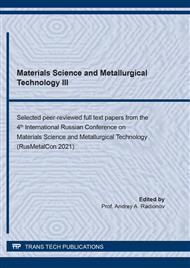[1]
P.P. Kukin, E.Yu. Kolesnikov, T.M. Kolesnikova, Environmental Impact Assessment. Security Expertise, Textbook and Workshop, first ed., Yu Wright, Moscow, (2016).
Google Scholar
[2]
S.V. Hetmantsev, I.A. Nechaev, L.V. Gandurina, Treatment of Industrial Wastewater with Coagulants and Focculants, Publishing House of the Association of Construction Universities, Moscow, (2008).
Google Scholar
[3]
Yu.V. Voronov, S.V. Yakovlev, Waste Water Disposal and Treatment: Textbook for Universities, fourth ed., Publishing House of the Association of Construction Universities, Moscow, (2006).
Google Scholar
[4]
A. Yunsi, Improving Reliability and Environmental Safety of Waste Water Treatment Systems of Electronic Industry Enterprises: thesis for the degree of Candidate of Technical Sciences, Moscow State Technological University, Moscow, (2017).
Google Scholar
[5]
E.V. Alekina, I.A. Sumarchenkova, The analysis of the methods of sewage treatment used at machine-building enterprises, Water Purification, Water Treatment, Water Supply. 1(97) (2018) 56-61.
Google Scholar
[6]
V.V. Semenov, S.N. Rodionov, A.F. Heredinikova, Improving the efficiency of reagent treatment of waste water of oil and fat production, Water Supply and Sanitary Equipment. 8 (2017) 34-39.
Google Scholar
[7]
S.O. Varaksin, V.A. Kolesnikov, Combined technology of treatment of waste water of galvanic production, Water Treatment. 7 (2012) 43-47.
Google Scholar
[8]
M.A. Barakat, New trends in removing heavy metals from industrial wastewater, Arabian Journal of Chemistry. 4 (2011) 361-377.
DOI: 10.1016/j.arabjc.2010.07.019
Google Scholar
[9]
A.A. Nekrasova, D.M. Privalov, M.V. Dvyanenko, N.M. Privalova, Study of sorption properties of filtration materials, Polythematic Network Electronic Scientific Journal of Kuban State Agrarian University. 126 (2017) 266-275.
DOI: 10.21515/1990-4665-126-020
Google Scholar
[10]
I.A. Nasyrov, G.V. Mavrin, A.R. Ahmetshina and A.I. Ahmadieva, Sorption properties of pyrolysis products of sludge, wood waste and rubber waste for heavy metal ions, Journal of Fundamental and Applied Sciences. 9 (1S) (2017) 1615-1625.
Google Scholar
[11]
I.A. Nasyrov, S.V. Dvoryak and I.G. Shaikhiev, Sorption properties of carbon waste pyrolysis product for biological wastewater treatment, Acta Technica CSAV (Ceskoslovensk Akademie Ved). 61(4) (2017) 323-330.
Google Scholar
[12]
I.A. Nasyrov, G.V. Mavrin, D.D. Fazullin, I.G. Shaikhiev, Investigation of the influence of ultrasonic treatment on the sorption properties of the pyrolysis product of wood waste, J. Phys.: Conf. Ser. 1347 (2019) 012080.
DOI: 10.1088/1742-6596/1347/1/012080
Google Scholar
[13]
L.N. Zhuravleva, A.N. Devyatlovskaya, The main directions of the use of wood waste, Actual Problems of the Forest Complex. 18 (2007) 96-99.
Google Scholar
[14]
I.A. Nasyrov, G.V. Mavrin, D.D. Fazullin and R.M. Khaidarov, Investigation of physicochemical properties and structural characteristics of pyrolysis product of wood waste, Amazonia Investiga. 7(17) (2018) 189-199.
Google Scholar
[15]
I.A. Nasyrov, D.D. Fazullin, G.V. Mavrin, I.G. Shaikhiev, Purification efficiency on the granulometric composition, HELIX. 9(5) (2019) 5532-5538.
DOI: 10.29042/2019-5532-5538
Google Scholar
[16]
D.D. Fazullin, I.G. Shaikhiev, G.V. Mavrin, Particle size and zeta potential changes in the disperse phase of water-emulsified waste waters in different treatment stages, Chemistry and Technology of Fuels and Oils. 51(5) (2015) 501-504.
DOI: 10.1007/s10553-015-0631-8
Google Scholar


